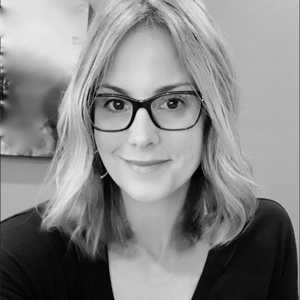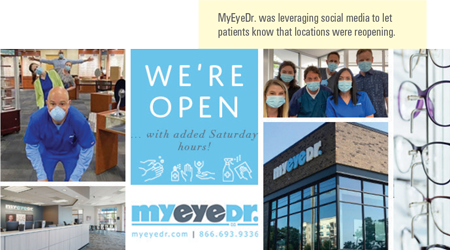

Dr. Albrecht’s private practice became a MyEyeDr. location in 2013. In her role recruiting and helping doctors integrate practices into the MyEyeDr. model, she has come to know many of the practices. She knew the dedication of MyEyeDr. providers and was unsurprised that telemedicine became an immediate shift that allowed practitioners to continue to see some patients. “We were always able to provide care for emergency patients,” she says. But for about six weeks when in-office care was paused, the practices did revise their telemedicine and on-call services.
“We had been starting to look at how to implement telemedicine in the future, especially for locations where doctor coverage was harder to provide,” she says. “We looked at different platforms, but the pandemic really accelerated things.” MyEyeDr. locations began by launching Eyefinity EHR in any offices where it hadn’t been and have since started working with the Eyefinity telemedicine platform with the goal to allow optometrists to be able to connect with patients.
READY TO HELP
“It was interesting for me, personally, to see how willing our doctors were to adopt and use technology in this way, something that they may have hesitated about earlier,” Dr. Albrecht says. “They knew that their participation in telemedicine, and even on-call emergency services, meant that we could help and do our part in keeping patients out of emergency rooms and urgent care centers so as not to overwhelm the front line.”
The experimental run with telemedicine during COVID-19 may look different in the future, but Dr. Albrecht says that she’s curious to see where it can go. She enjoyed testing the capabilities of different systems. As insurers provide increased coverage for telemedicine services and more standard, HIPAA-compliant protocols are used, it could improve patients’ access to providers. “We would be able to streamline our on-call ability, and we could provide additional access where we have limited coverage.”
As patients begin to return to their doctors’ offices, telemedicine could also potentially relieve some of the strain on the backlog of calls. “If we can have a combination of the ability to see patients in office and follow up with a telehealth platform, that backlog could be relieved more quickly.”
REOPENINGS
MyEyeDr. began reopening locations in late April with about 117 locations reopening, followed by another 200 or so in mid-May. Dr. Albrecht says that the protocols of “open” offices follow state health department, Centers for Disease Control and Prevention and American Optometric Association guidelines. These protocols included asking patients screening questions; taking temperatures; having doctors, staff and patients wearing masks MyEyeDr. provides; and limiting the number of people inside the location at one time.


PLANNING FOR THE FUTURE
MyEyeDr. has significant experience in opening and merging practices into the MyEyeDr. model. It had no experience in how to pause in-office care for hundreds of practices on a nationwide scale. That necessity of systematically shutting location doors, keeping doctors and essential employees working from home and then reopening in phased approaches showed the need for a better regional and national disaster plan.
“Even if it felt like we were flying blind some days, it was a true learning experience,” she says. She and the others on the team continually collected best practices that they could share. That helped them guide practices in a more systematic way. “We’d try it one way, and if we were not able to provide the support to doctors and patients, we shifted and redirected so that we could.”
In her conversations with potential integrations, Dr. Albrecht already spends time talking with doctors about long-range planning. Some eye care professionals become MyEyeDr. practices because there’s a family emergency or they’re concerned about their own health issues and that threatens their practice future. “We often spend time talking about the necessity of a plan for the unexpected,” she says.
And while no organization was prepared for a pandemic of this scale, she says so many doctors were grateful that they were not trying to navigate through the maze alone as solo private practitioners.
COMMUNICATION IS KEY
Just as providers need to have discussions with patients to let them know the status of what to expect, organizations also have to be transparent with their teams. It’s challenging when the ground shifts almost daily, Dr. Albrecht says. “We want our patients, doctors and staff to feel that all of us are in
this together.”



